Food
If you want to see what the normal sort of menus at Scott Base are like, then look at these lists which are hot off the press.. Each menu list is for a week, not including Sunday !!
![]() Menu1,
Menu1, ![]() Menu2,
Menu2, ![]() Menu3,
Menu3, ![]() Menu4,
Menu4, ![]() Menu5,
Menu5, ![]() Menu6
Menu6
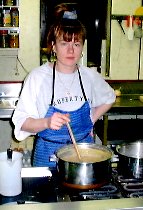 In this section I have asked Pauline, our chef,
to help me out with certain parts. I asked her a whole heap of
questions about food and related subjects. Some of the questions
have already been asked by kids sending me emails. I also added a
few more questions that I thought people would be interested in.
Here are her answers, (with a few little comments of mine thrown
in).
In this section I have asked Pauline, our chef,
to help me out with certain parts. I asked her a whole heap of
questions about food and related subjects. Some of the questions
have already been asked by kids sending me emails. I also added a
few more questions that I thought people would be interested in.
Here are her answers, (with a few little comments of mine thrown
in).
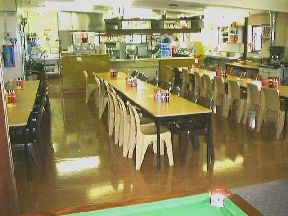 This is the mess (dining area ) during the summer. It can seat
and serve up to about 80 people. During the winter we only have the table to
the far right and the rest of the space is taken up with a big lounge suite
and a TV; nice and comfortable, just like home!! The bar is where I took the
photo from and you can just see the edge of the pool table.
This is the mess (dining area ) during the summer. It can seat
and serve up to about 80 people. During the winter we only have the table to
the far right and the rest of the space is taken up with a big lounge suite
and a TV; nice and comfortable, just like home!! The bar is where I took the
photo from and you can just see the edge of the pool table.
Bits of the kitchen, Ovens and a Bench work area
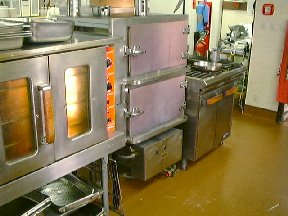

* How often do you get food supplies ?
Most of the food is brought down on a ship at the beginning of February; that is all the canned goods, dry goods, frozen meats, vegetables, fish and seafood. The food that comes down on the ship has to last a full year.
When the flights come down during the summer season, approximately every four weeks, we get all our fresh produce. If we need any other supplies, such as cheeses, eggs and other perishable goods, we order them to come down with our fresh produce.
* Where and how do you store all the food ?
The food is stored in various places around the base. In the kitchen are all the stores required on a day to day basis. They are kept in either the walk-in fridge, the freezer, or the dry store in the kitchen.
Many of the stores are kept in the hanger through the year . The hanger is not heated, so for most of the year everything stays frozen. We have a very large stand alone walk-in freezer behind the main accommodation block where we keep all our frozen meats, fish, ice cream, etc. This gets turned off over winter as it is so cold here we don't need to be worrying about keeping things frozen. It is kept at a minimum of -18 degrees Celsius or colder.
We also have what we call a warm store. Such things as eggs, cheeses, potatoes, pumpkins, relishes, chutneys, oils and some canned goods are stored in here. The temperature is kept at a steady 8C as the items that are in here either don't freeze very well, or it's too hot or cold in the kitchen.
* How long does the food last? What is the difference between summer and winter menus.?
As most of our stores are frozen they will last at least a couple of years, more so for the dry goods, such as flour, sugar, salt etc.
During the summer when we receive fresh produce, this can last up to a month, some things such as cauliflower and cabbage can last for almost two months.
* Are there special things you have to do with the food to make it last?
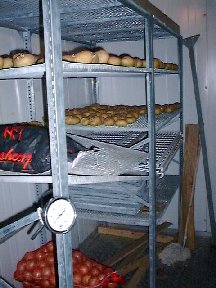
Warm Store for potatoes and onions.
Our eggs are sprayed with oil and have a shelf life of ten or more months. The oil stops the air from getting into the shells, keeping them from going off (rotting). The potatoes are kept out on open trays in the warm stores where it is dark. This stops them from sweating or growing sprouts and they last much longer.
As long as the food is stored properly, the shelf life is quite good.
* How far in advance do you order the food?
Most of the food is ordered before the middle of January so that it can come down on the ship the beginning of February. With our fresh produce we usually allow a week before we actually want it. Due to inclement weather conditions, sometimes we won't receive our fresh produce (freshies) till three weeks or more after ordering it.
* How long do you spend in the kitchen each day, summer and winter?
Generally over summer we would start at 7am and finish about 6.30pm. Because there were two of us, we would sometimes split shifts so that I might do the morning and Jeff might do the evening. I work six days a week and have one day off. Jeff (the summer chef) left at the end of February and from then until October I do all the cooking for twelve people. That includes morning teas, lunches, afternoon tea breaks, dinners, deserts, baking and extra meals for visitors and special occasions.
In the winter I start work at 8am and finish at 5.30pm and can afford to take several hours off in the day between meal preparation. This is due to the low numbers of staff on base. Cooking 2 meals a day for 12 people is alot easier than cooking 3 meals a day for between 40 and 70 people.
* How much food do you prepare, and how do you know how many people you are going to feed each day?
During the summer season we are given a number in the morning as to how many people we will have on base for dinner time. This can vary between 35 and 75 people. Sometimes plans would change if a plane was turned back due to bad weather, and other times we would set aside food for those who would arrive late.
We always like to cater for an extra five people just so that we always have enough and don't run out.
* Do you have to prepare set menus or do you cook what you want?
We make up our own menus and try to make as varied a choice as possible. We probably do cook more of what we like because we can. Some days its a bit of a struggle trying to think up something different to feed people, but I always seem to get a flash of inspiration at the last minute and throw something together. No complaints yet !!
* What happens to the waste food?
We always try to use up any leftovers so that we don't have to waste anything. Any waste food that we do have is put into blue bags and incinerated. All the cans are washed and the labels taken off and then crushed and put in black bags and taken back to N.Z on the ship. All boxes are broken down and tied in bundles for return to N.Z. Plastics and glass are also washed and returned.
* What happens if you run out of food?
People would die from starvation. ( Just kidding !!) We have at least two years supply of extra food so it hopefully wouldn't be a problem.
* Do you do any special meals?
We sometimes have theme nights such as fish and chips night where the food is ordered at the counter and served wrapped up in paper. On Sunday nights we have a BBQ. Other times we have done blokes meals on a Wednesday night which is a sausage, eggs and chips night. It was kinda forced onto us chefs, so we got our own back and made them eat elaborate girlie desserts.
A Barbecue in the garage is a common thing for a sunday meal during the summer. If your out in the field you have to do a bit of cooking in a tent or shelter.
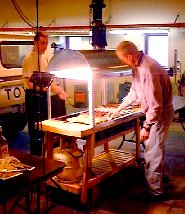
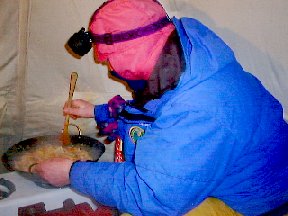
Below are a small
combination of photos from some of the larger official dinners we
have put on; Mid Winter and End of Summer Light (The normal day-to-day
dinner we get is the top right photo.) Pauline does an excellent
job of telling us what needs to be done so her meals are ready on
time. The rest of use do our bit to get the dining room ready.
Being a pastry chef Pauline puts alot of effort into deserts (as
well as the normal meals).
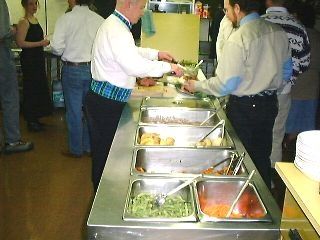
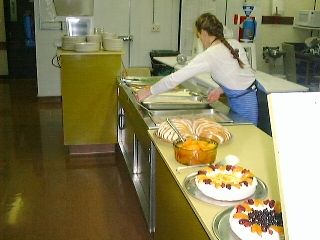
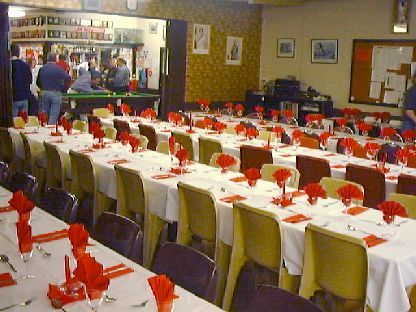
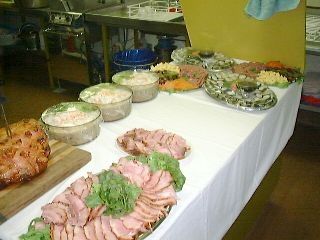
Hydroponics
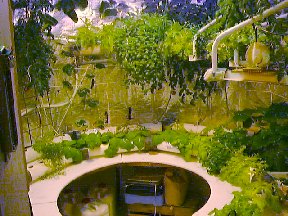 Scott
Base uses a small hydroponics unit during the winter to keep a
small supply of green stuff on the menu. Pauline and Helen look
after the hydroponics by making sure plants are given the right
doses of nutrients. Towards the end of summer they went in and
started growing seedlings. When winter came the plants were ready
to put into nutrient baths. The hydroponics tanks use a
combination of artificial lighting. The lights are on a timer so
at night the lights are turned off automatically, simulating
normal daylight hours.
Scott
Base uses a small hydroponics unit during the winter to keep a
small supply of green stuff on the menu. Pauline and Helen look
after the hydroponics by making sure plants are given the right
doses of nutrients. Towards the end of summer they went in and
started growing seedlings. When winter came the plants were ready
to put into nutrient baths. The hydroponics tanks use a
combination of artificial lighting. The lights are on a timer so
at night the lights are turned off automatically, simulating
normal daylight hours.
 The hydroponics units produce enough green stuff for a small salad
every couple of days. A variety of stuff is grown in the tanks, i.e. lettuces,
tomatoes, zucchini, etc.
The hydroponics units produce enough green stuff for a small salad
every couple of days. A variety of stuff is grown in the tanks, i.e. lettuces,
tomatoes, zucchini, etc.
It's the first zucchini of the season and both Helen and Pauline are very proud of their achievement. I heard them boasting about it in the kitchen, so I made them take it back down to hydroponics and I took a picture.
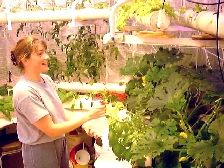 Helen is doing a bit of leaf watering. The plants get more than
enough water through the roots but a bit of water on top and around the leaves
helps the plant (we think it does anyway). We use reverse osmosis water that
has been purified twice (2RO) to feed the plants. It's the same water that we
use for drinking; very pure, only about 3 ppm contamination. Distilled water
is only 2 ppm.
Helen is doing a bit of leaf watering. The plants get more than
enough water through the roots but a bit of water on top and around the leaves
helps the plant (we think it does anyway). We use reverse osmosis water that
has been purified twice (2RO) to feed the plants. It's the same water that we
use for drinking; very pure, only about 3 ppm contamination. Distilled water
is only 2 ppm.
www.geocities.com/coolrunnernz/
9-3-01
Re-Edited by Shirley Baston Fred - [email protected] - ICQ #15167279